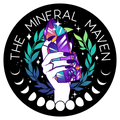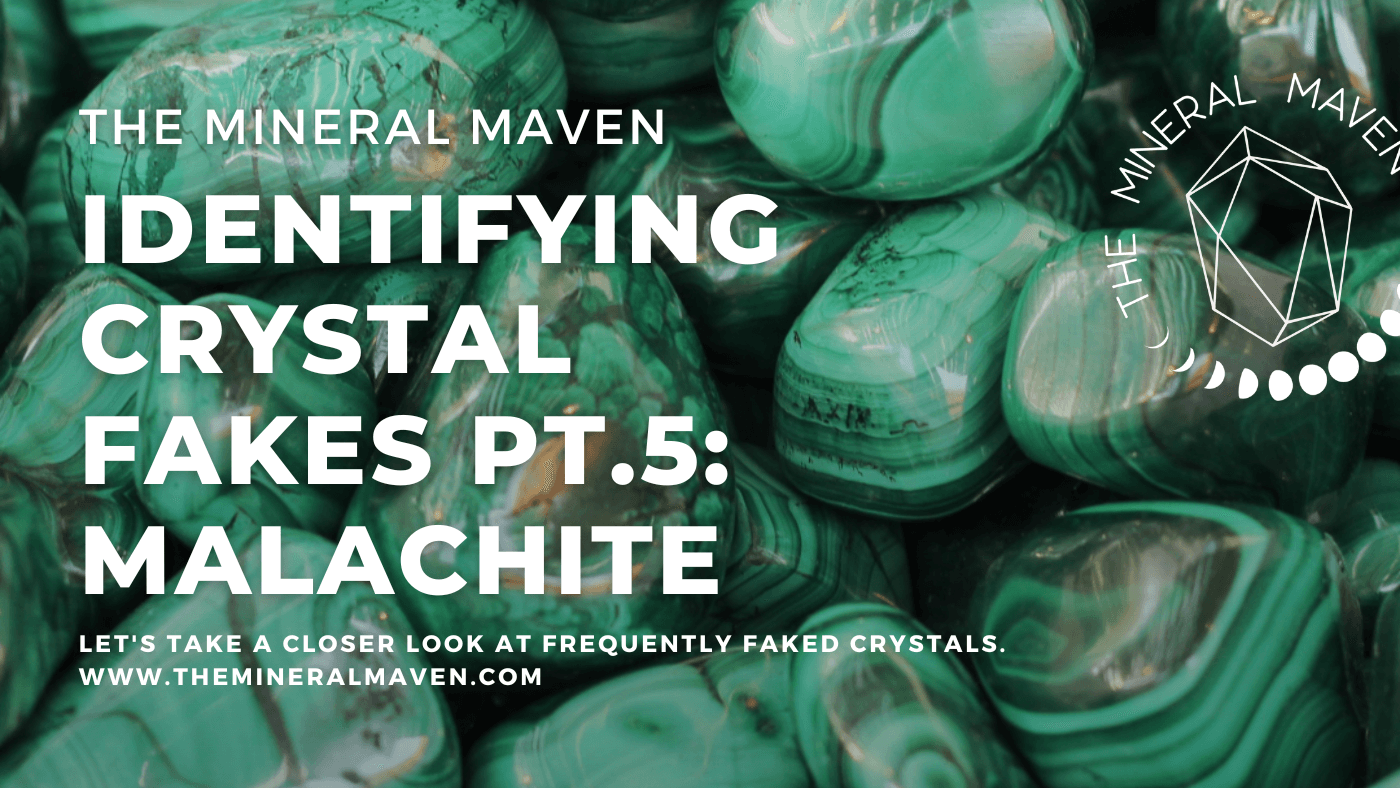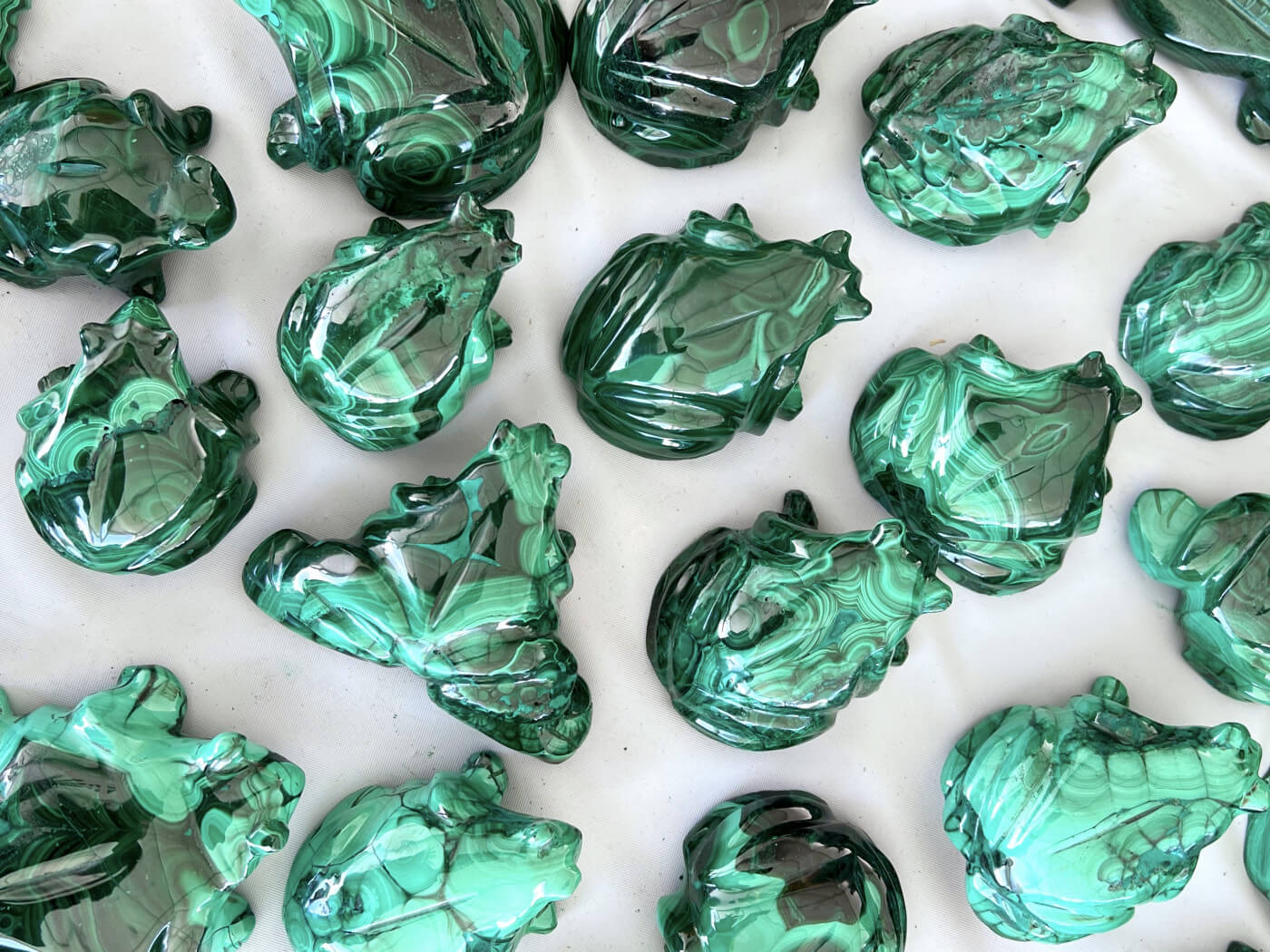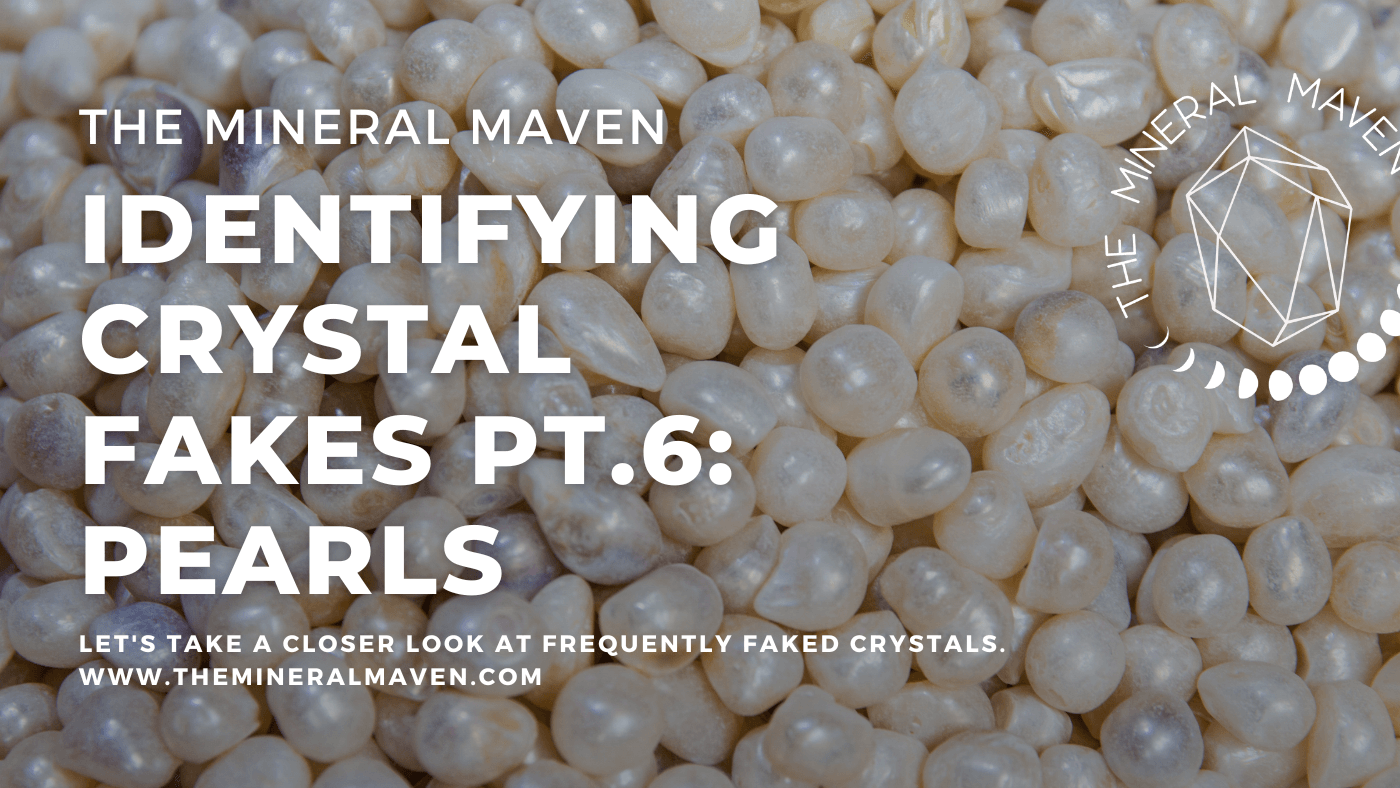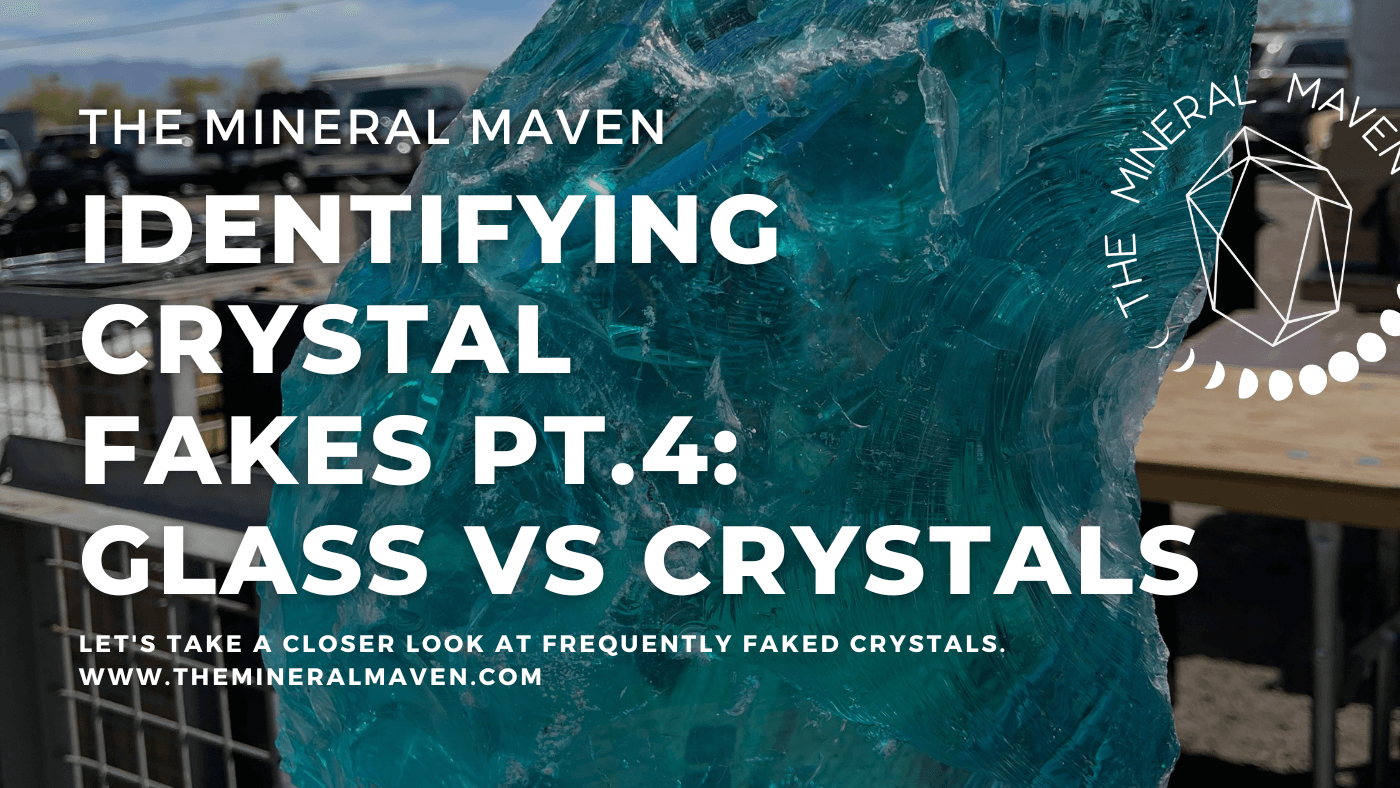Lately, I've been seeing a surge in fake malachite being sold as “natural” with zero disclosure about it being “imitation” or synthetic. Sometimes you will even see malachite labelled as reconstituted, when it's clearly completely man-made. This has become increasingly prevalent in the jewelry market, even from larger retailers and otherwise reputable jewelry makers and small businesses.
Otherwise reputable businesses who are selling fake malachite as natural aren’t always doing this to be deceiving. Many probably don’t even realize it's fake! Their vendors are selling it to them as real, and they often aren’t doing enough research or vetting the authenticity for themselves. Sometimes they aren’t as well-versed in stones and lack experience/expertise in IDing fakes - so makers, retailers, and customers alike, please be sure to do your own research!
Genuine Congolese malachite carved into frog shapes (not fake malachite!)
About Malachite
Malachite is a copper carbonate hydroxide mineral with a hardness of 3.5-4 on the Mohs scale, which means it's quite soft and can scratch relatively easily.
Though malachite was one of the first ores used to produce copper metal, it is not used as much today because it's more valuable as a specimen/jewelry. It's been revered by humans for over 4000 years and used as a sculptural material & as a gemstone. Ancient Egyptians even used ground up malachite as pigment. Today it is most often sold polished and cut into cabochons or beads for jewelry.
Most malachite deposits have been aggressively mined, so while it's historically been found in Egypt, Palestine, and Russia - most of today's material is mined in the Democratic Republic of the Congo, with small deposits in Morocco, Australia, France, & the US (namely Arizona).
Malachite is a striking green color that doesn't fade in sunlight or over time. It forms at shallow depths in oxidizing zones above copper deposits, in a favorable subsurface chemical environment that also facilitates formation of Azurite, Bornite, Calcite, Chalcopyrite, Chrysocolla, Copper, Turquoise, and other iron oxides. This is why you often find it alongside Chrysocolla and Azurite in mixed specimens.
Natural malachite comes in many forms: including botryoidal formations (like "forbidden broccoli"), a cluster shape called "velvet" malachite due to its velvet-like texture, and sometimes as stalactites and botryoidal coatings in caves. These formations are echoed in the natural swirls and bullseyes you can see in polished malachite.
As someone with identification experience (and buying experience in general), I have found it quite easy to determine real malachite because of the bright polished luster, the unique banding and gradient, and the eyes. However, I understand it may be more challenging if you don't know what to look for, so I'll do my best to share some tips.
(Reference: "Malachite" article on Geology.com by Hobart M. King, PhD, RPG)
MALACHITE SAFETY
Malachite is technically toxic because of its copper content, but the danger comes when small particles become airborne and get inhaled (like when cutting and polishing is happening - protective gear is paramount). I also wouldn't recommend putting it in water because it can both damage the stone and it can make the water unsafe.
While I do recommend washing your hands after handling raw malachite, polished malachite is very safe! You can handle polished malachite, wear malachite jewelry, etc without worrying.
As with any crystal - I NEVER recommend ingesting stones, placing them inside of your body, or drinking direct-infusion elixirs (e.g. crystal water bottles).
An up-close look at 2 genuine malachite specimens, to get a better look at the natural gradients and swirls.
Fake Malachite
Personally, the main avenue I've seen fake malachite peddled is through beads and jewelry. It's readily faked because - like with Turquoise and all faked crystals - it's both valuable and rare.
PRICE
The biggest red flag is always pricing, especially on platforms like Wish and Ebay - but there may be more convincing fakes and more in-line pricing even on Etsy and at more reputable spiritual retailers. Real malachite isn't cheap - if it seems too good to be true, it probably is.
MATERIAL
Fake malachite is often made of resin/plastic, glass, or clay/ceramic. And like with Turquoise, it can be ground up and reconstituted from malachite powder and sold as natural malachite. Fake malachite often (but not always) appears more dull than a high quality piece of real malachite, though low quality malachite can also be easily dulled with scratches.
COLORING
Malachite naturally features all shades of green (light to dark) in alternating bands & swirls. Fake malachite will usually have one-dimensional light green, dark green and black stripes, with harsh contrast and very blocky appearance. Natural malachite doesn't contain true black coloring, but it will contain green so dark that it appears black. Fake malachite often has black stripes.
PATTERNING
Natural malachite has all kinds of swirls, circles/eyes, waves, rings, and stripes. It can be more pronounced, but is often softly faded between shades of green. Fake malachite usually has super uniform lines and harsh alternating between green and blackish.
FEEL
I know you can't do this online, but natural malachite has some weight to it. It's also cool to the touch, whereas plastic/resin will be warm or room temp and lightweight compared to genuine malachite.
An up-close look at 2 examples of fake malachite - a tumble and a bracelet.
IMPORTANT NOTE ABOUT REPAIRS
You will sometimes see a uniform green patch or a disruptive pattern on a piece of polished malachite that otherwise looks very real. This is not an indicator of fake malachite - this is usually just a repair/patch that was done to make the malachite more suitable for polishing.
Natural malachite is botryoidal and fibrous, which means there are gaps and voids, and it's a very soft stone. Lapidary artists will fill in those gaps with repairs (which are typically leftover bits of malachite mixed with dye and resin to make it easy to fill with) to make it easier to carve. This is a common practice.
This is an industry standard practice and does not need to be disclosed, it's extremely prevalent and often hardly noticeable. Natural malachite with no repairs done will have cracks and gaps, due to how the stone forms. For a smoother surface and polish (common with malachite animal shapes, eggs, spheres, etc.) the stone is repaired.
A Word on Ethical Sourcing
I'd be remiss to praise the beauty of natural malachite without also acknowledging the ethical challenges that come with sourcing this material.
There are major ethical concerns with sourcing any mined material from the Democratic Republic of the Congo (DRC) because of the egregious human rights abuses, exploitation and forced labor (including children) in the industrial mining field. With the rise in clean energy technologies, we have also seen a rise in demand for cobalt - and DRC has the world's largest reserves of cobalt. Copper is another industrial mined material that, along with cobalt, is driving these abuses.
Specimen mining is done on a much smaller scale than industrial-level mining like we see with zinc, cobalt, copper, etc. but we still need to take every step possible to ensure that there is transparency, safety, and ethical treatment of all people who extract and prepare these beautiful stones that we enjoy.
Short of visiting DRC ourselves, the best way to support ethical treatment of Congolese people mining and doing lapidary work is to purchase as close to the source as possible and to support fair prices. This is a universal tenant of ethical sourcing - to buy as close to the source as possible, and to practice transparency to ensure you know who your stones are coming from and how those folks are being supported (financially and in regards to safety and benefits). The more middlemen involved, the less money the folks at the source are receiving, and the more muddy the waters become as far as transparency is concerned.
MY MALACHITE SUPPLIERS
I source all of my malachite pieces from one supplier - a Congolese couple that I've been working with for almost 5 years now. They are truly wonderful people and I look forward to shopping with them multiple times a year. These folks work tirelessly to sell their material, traveling the country to set up at gem shows all year long, so they can give more business to the families they work with back home in DRC and better support their livelihood. As members of the community - they know the folks doing the mining and the lapidary work, and they support them with a steady stream of income through their export business.
The only exception are my malachite bracelets - the beads are sourced from my bead supplier instead of my usual malachite supplier (since they don't make beads).
More about my bead supplier:
They're a US-based supplier who practices responsible sourcing and manufacturing.
For the product they mine themselves, they strive to minimize their mining impact, and take measures to protect local water sources from pollution and blockage. Once mining is concluded, they replant native trees and flora to minimize impact on local ecology.
For their lapidary artisans, they ensure their employees are paid a fair wage, provided safe working conditions, and given comprehensive healthcare and benefits. Their craftsmen are paid above market price for their work.
I hope that this blog provides a good starting point for identifying fake malachite in the market, so you can better vet malachite jewelry and we can start normalizing more transparency around retailers disclosing synthetic/imitation malachite when it's used. Of course, it isn't comprehensive and they are getting better at manufacturing more convincing fakes, but this can help you weed out the tell-tale synthetics. As always, the best route is to buy from a retailer you trust.
I'll add that there's nothing wrong with purchasing or enjoying synthetic malachite, but my issue with all crystal fakes is the lack of transparency for both suppliers and retailers. I believe if someone wants to sell heavily treated, synthetics or imitation stones they should absolutely be disclosing that to their customers at the point of purchase.
Please feel free to comment with any additional questions below and subscribe to my newsletter so you don't miss the next blog installation of Crystal Fakes.
MALACHITE TUMBLE
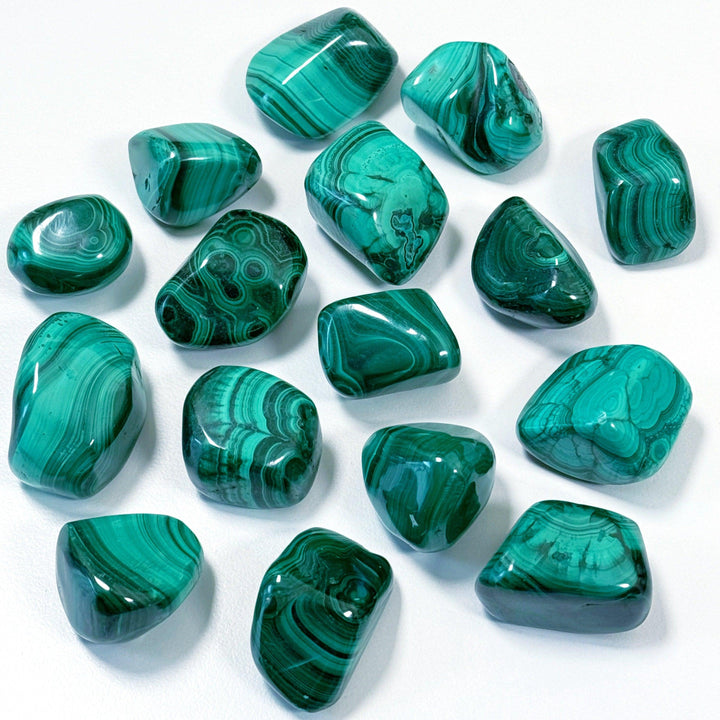
$8.00
This listing is for (1) malachite tumble, which will be intuitively selected. As these are natural stone, there is some natural variation in color, appearance and size. These are a beautiful quality. Each is approx. 1"+; photo in my hand… read more
MALACHITE 6mm - HANDMADE CRYSTAL BRACELET
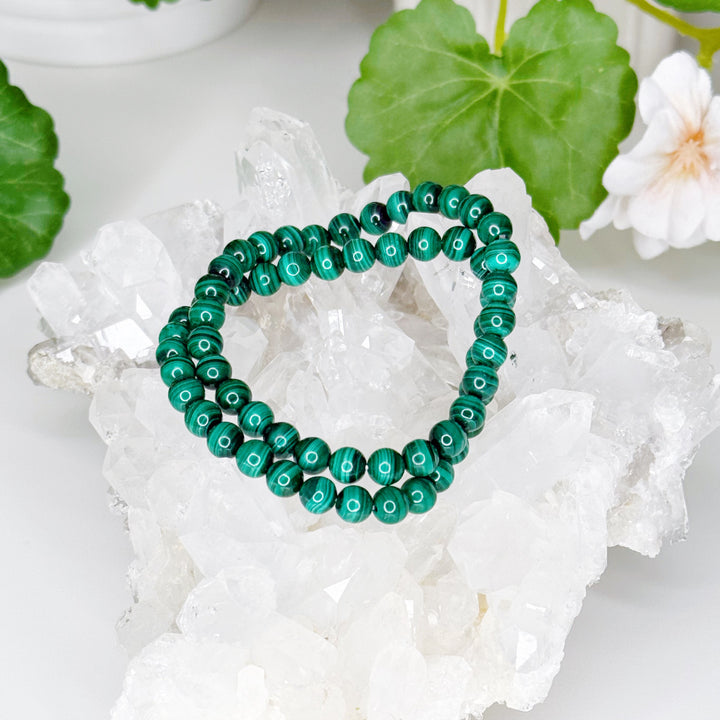
$29.00
PROTECTION - TRANSFORMATION - EMOTIONAL HEALING This listing is for (1) Malachite (6mm) handmade crystal bracelet. Your bracelet will be intuitively selected, and the stone beads may vary slightly but will appear similar to those shown. Elastic with approximately 7" length, approximately… read more
POLISHED MALACHITE
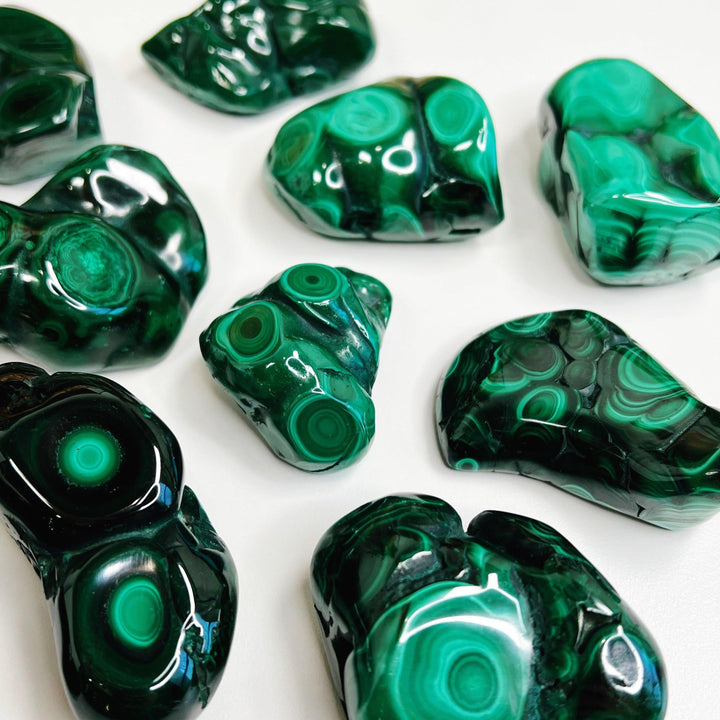
$30.00
This listing is for (1) polished Malachite specimen, intuitively selected. As these are natural stone, they may vary from those pictured here and have surface imperfections (pitting, chips, scratches, etc) due to the soft nature of Malachite. Each piece is approx. 40-130g. As these… read more
MALACHITE FROG
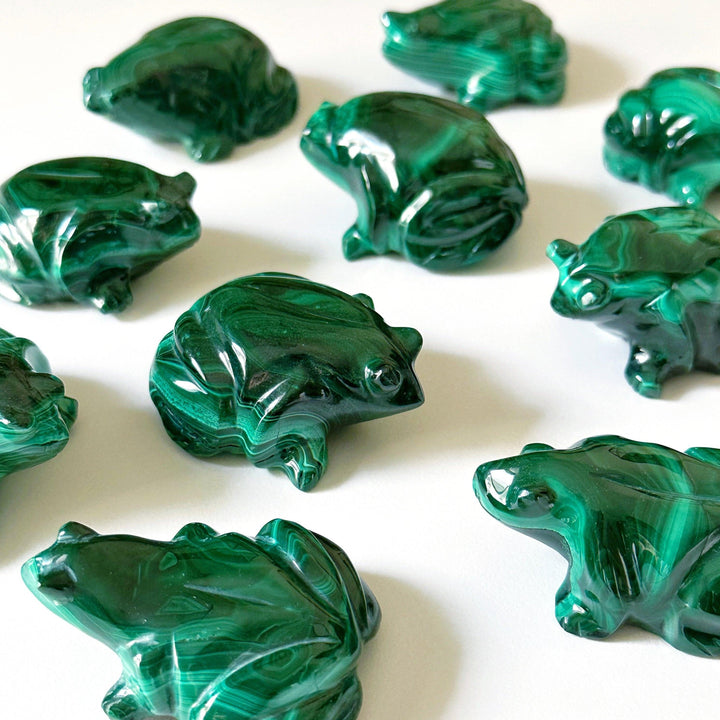
$33.00
This listing is for (1) polished Malachite frog, intuitively selected. As these are natural stone, they may vary from those pictured here and have surface imperfections (pitting, chips, scratches, etc) due to the soft nature of Malachite. Each piece is approx. 2-3" in… read more
